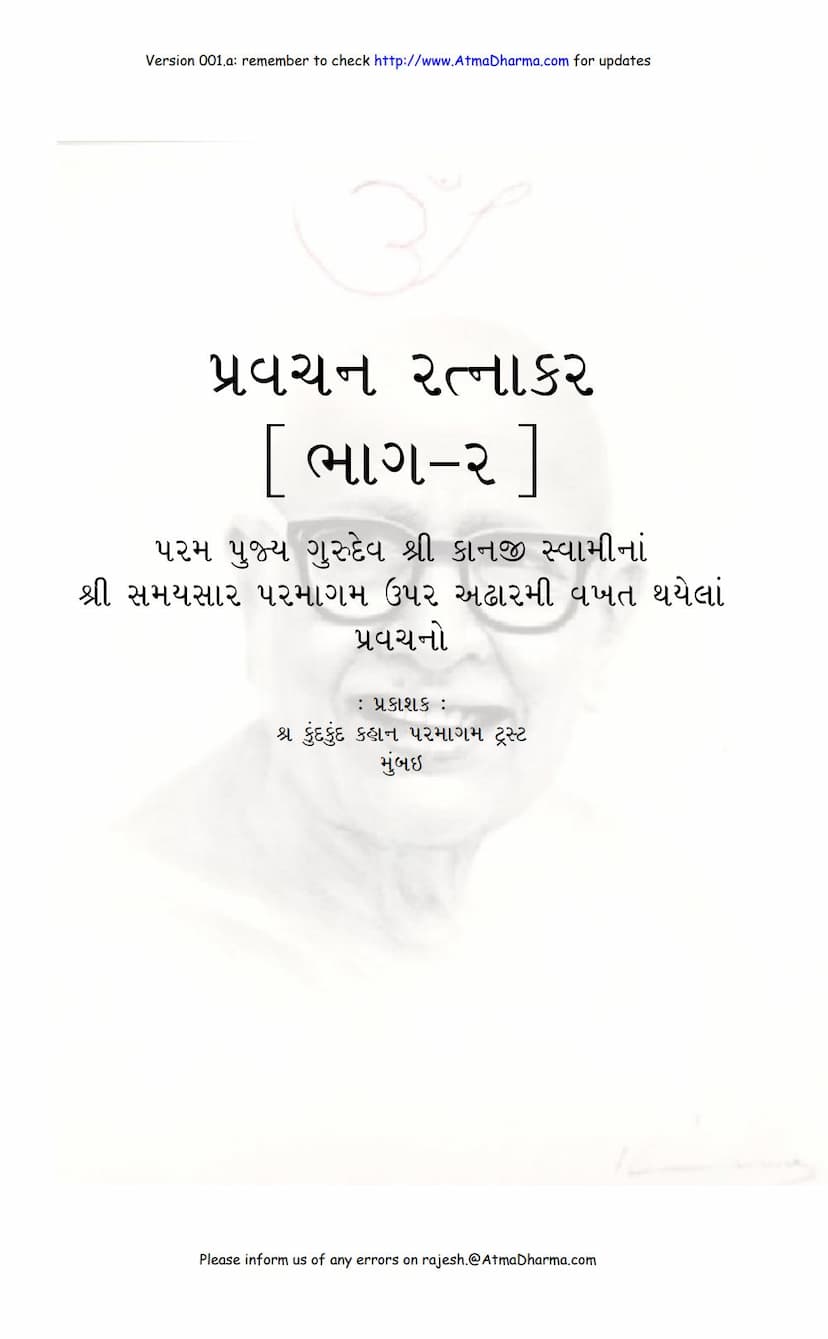Pravachana Ratnakar 02
Added to library: September 2, 2025

Summary
The provided text is a Gujarati translation of lectures by Kanjiswami on Acharya Kundakunda's "Samaysar Paramagam," specifically focusing on Part 2 of "Pravachan Ratnakar." The book is published by Shri Kundkund Digambar Jain Paramagam Trust.
Here's a comprehensive summary of the content based on the provided pages:
Book Overview and Purpose:
- Title: Pravachan Ratnakar (Discourses on the Jewel of Truth), Part 2.
- Author: Param Pujya Gurudev Shri Kanji Swami.
- Subject: These are discourses delivered for the eighteenth time on Acharya Shrimad Kundakunda's "Samaysar Paramagam."
- Publisher: Shri Kundkund Digambar Jain Paramagam Trust, Mumbai.
- Goal of Publication: The primary aim is to benefit private study and provide continuous access to the profound teachings of Samaysar. It also aims to help future generations understand the subtle and profound truths within Samaysar, as the spiritual capacity of beings is declining in this era. The publication of these discourses is seen as an effort to preserve the correct understanding and tradition of Jinavachana (teachings of the Jinas).
- Dedications: The shastra (scripture) was donated by Dilipbhai Juthalal Shah from London, UK, who funded its digitization.
Key Themes and Content (based on the verses discussed):
The text delves into the core principles of Jainism, particularly as expounded in Samaysar, with a strong emphasis on Nischaya Naya (the ultimate truth perspective) versus Vyavahar Naya (the conventional or practical perspective). The central theme revolves around understanding the true nature of the soul (Jiva) and its distinction from non-soul (Ajiva) elements, including the body (Deha) and karmic matter.
The lectures appear to meticulously explain key verses and philosophical concepts from Samaysar, as indicated by the references to specific verses (Gathas) and commentaries (Tikas). The discussions highlight the following:
-
The Nature of the Soul (Jiva):
- Knowledge-Intrinsicality: The soul is described as the essence of knowledge (jnana-ghana), eternally existing and self-aware.
- Distinction from Body and Karma: A significant portion of the discourse emphasizes the absolute distinction between the soul and the body, karmas, and other external substances. The soul's true nature is characterized by knowledge, consciousness, and bliss, which are entirely separate from the physical body and the effects of karma (like passions - kashayas, actions, etc.).
- Soul as the True Object of Devotion: The lectures stress that the soul (Atma) itself is the ultimate object of meditation and devotion. External rituals or veneration of the body, even that of Tirthankaras or Jinas, are considered indirect or conventional means (Vyavahar Naya) if not ultimately leading to the recognition and realization of one's own soul.
-
Nischaya Naya vs. Vyavahar Naya:
- The text frequently contrasts the Nischaya Naya (ultimate truth, reality as it is) with Vyavahar Naya (conventional truth, practical reality).
- Vyavahar Naya: This perspective acknowledges the conventional interconnectedness or perceived unity, such as the soul seemingly being one with the body or experiencing karmic conditions. It's how the world appears and how teachings are often conveyed practically. For example, the body's attributes are spoken of in the context of Tirthankaras, but this is a concession to conventional understanding.
- Nischaya Naya: This perspective emphasizes the absolute separateness of the soul. The soul is eternally pure, formless, and unaffected by any external factors like body, karma, or passions. The true realization (Anubhava) of this Nischaya Naya is the path to liberation.
-
The Path to Liberation (Moksha):
- Knowledge (Jnana) as the Means: The lectures highlight the paramount importance of Samyak Jnana (Right Knowledge) – the direct realization of the soul's true nature.
- Right Faith (Samyak Darshan) and Right Conduct (Samyak Charitra): These are presented as integral to the path. Right faith is the firm conviction in the soul's true nature, and Right Conduct is the consequent living in accordance with that knowledge, which is characterized by non-attachment and equanimity (Vitraagta).
- Self-Reliance: The emphasis is on self-reliance in realizing the soul. No external entity (like deities, rituals, or even the Tirthankaras' physical form) can grant liberation; the path lies within one's own soul.
- Rejection of External Rituals as the Sole Path: While acknowledging that practices like austerities (tapas), vows (vratas), and devotion (bhakti) might have a conventional role, the ultimate liberation is achieved through the direct realization of the soul's true nature, which transcends all external activities and passions.
-
Key Concepts Illustrated:
- Soul as Knowledge-Intrinsical: The soul is equated with pure knowledge and awareness.
- Indriyas (Senses) and their Control: The lectures discuss how the true path involves transcending the sensory perceptions and the worldly attachments they generate. Controlling the senses (Jitendriya) is crucial, not by mere suppression, but by realizing the soul's independence from them.
- Moha (Delusion) and its Overcoming: The text explains how delusion (moha), which binds the soul to non-soul elements, must be overcome through discrimination (Bheda Jnana) and the realization of the soul's true nature. This leads to the state of Jitmohan (one who has conquered delusion).
- The Goal: Liberation (Moksha): The ultimate aim is described as realizing one's pure, eternal, and blissful soul, free from all karmic bondage and worldly suffering. This is achieved through the direct experience (Anubhava) of the soul's true nature, which is beyond cause and effect and untouched by external factors.
The overall tone is deeply philosophical and aimed at guiding the listener towards self-realization through a rigorous intellectual and spiritual understanding of Jain principles, as presented by the revered Acharya Kundakunda and elucidated by the contemporary spiritual master Kanji Swami. The detailed explanations and refutations of common misconceptions highlight the depth of the spiritual path described.